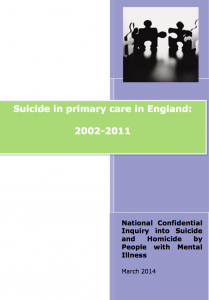
The National Confidential Inquiry into Suicide and Homicide by People with Mental Illness was established in its current form at Manchester University in 1996. From 1991, prior to the move to Manchester, research in this area had been managed within the Royal College of Psychiatrists.
The NCISH has established an outstanding national and international reputation for the quality of its research. It uses a range of methodologies such as case-control studies, psychological autopsy and data linkage along with access to other large health data sets, such as practice lists, to explore the difficult and troubling subjects of suicide and homicide. The NCISH has produced a series of reports which are aimed at learning the lessons from these terrible personal tragedies and improving practice across mental health and related services.
The unit’s previous report highlighted the fact that though the number of homicides by people with mental health problems had fallen, the number of suicides in this group has actually risen. A rise in suicides is associated with a period of economic austerity where people face increased financial and social pressures, but there are reductions in public health and general welfare provisions.
Methods
Last month saw the publication of the new NCISH report into suicide in primary care in England. The research team used the Clinical Practice Research Datalink (a database that holds over 5 million electronic patient records) and Office of National Statistics (ONS) data.
The research looked at 2,384 patients who died by suicide over a 10 year period (2002-2011). These patients were matched with 46,899 living patients with similar characteristics such as age, gender and GP practice. Thus there were up to 20 control patients for each patient who died by suicide. All the patients who had died by suicide where over 16 years of age. Through this case matching, the researchers examined:
- Frequency and patterns of GP consultations
- Diagnosis of mental illness
- Prescription of psychotropic drugs
- Referral to specialist mental health services

The report confirms that middle-aged men are a high risk group for suicide
Results
- 76% of patients who died by suicide were male – the median age was 45. This finding supports other suicide research that highlights middle-aged men as being a high risk group
- The study examined how often the patients had been to see their GP in the year prior to the suicide:
- 63% had done so but there was significant variation in the number of appointments (between 1 and 24)
- 37% of this group had not been to see their GP in the previous 12 months. This group was more likely to include male patients, but also younger men and women
- The non-attenders were also less likely to have a mental health diagnosis
- The majority of the group 1,497 (or 63%) who died by suicide had a mental health diagnosis
- The most common diagnosis was depression, but only 8% had been referred to mental health services in the previous 12 months
The study also examined the patterns of prescribing. It concluded that patients who died by suicide were:
Five times more likely to be on psychotropic drugs, five times more likely to be on antipsychotic drugs and seven times more likely to be on antidepressants.

Being prescribed more than one type of drug was associated with an 11-fold increase in suicide risk
Conclusions
The report has some very important messages for primary care, which it should be remembered is the focus of most mental health provision.
The study indicates that mental illness amongst those who eventually die by suicide is frequently unrecognised in primary care. The current pressures on such services might increase these risks.
However, there is also an issue here about outreach working and encouraging individuals to seek support. As the report notes, non-attendance is an indicator of increased risk. This is a much wider public health issue as this pattern can be seen in other areas of health care for the groups that are most at risk – young males in particular. This is an area where the voluntary sector and other agencies such as colleges, community groups have a key role to play.
The short-sighted nature of the austerity policies means that the pressures on these services means that they are struggling to meet demands, just when their services are needed most.

Mental illness in those at risk of suicide is often not picked up in primary care
If you need help
If you need help and support now and you live in the UK or the Republic of Ireland, please call the Samaritans on 116 123.
If you live elsewhere, we recommend finding a local Crisis Centre on the IASP website.
We also highly recommend that you visit the Connecting with People: Staying Safe resource.
Link
Suicide in primary care in England: 2002-2011. National Confidential Inquiry into Suicide and Homicide by People with Mental Illness (NCISH) (PDF). Manchester: University of Manchester 2014.


Suicide in primary care: findings of National Confidential Inquiry Suicide and Homicide by People with Mental Illness http://t.co/ltPZpWTwbU
Suicide in primary care: findings of the National Confidential Inquiry into Suicide and Homicide by People wit… http://t.co/qfKs131evw
Read @IanCummins9 on the National Confidential Inquiry into Suicide & Homicide by People with Mental Illness http://t.co/654xJBcN7f
Suicide in primary care http://t.co/HdAvnYk8VV @NCISH_UK
Time for mental health professionals in all primary care practices?? One health.
RT @mcpherson_ian: ‘Suicide in primary care: findings of the National Confidential Inquiry”: some important messages for GPs & PC staff htt…
Mental Elf: Suicide in primary care: findings of the National Confidential Inquiry into Suicide and Homicide by… http://t.co/1FV0LVzLjk
Please let us know your thoughts on our blog about suicide in primary care http://t.co/654xJBcN7f @ProfLAppleby @NCISH_UK
Recent @NCISH_UK report confirms that middle-aged men are a high risk group for suicide http://t.co/654xJBcN7f
Being prescribed more than one type of drug is associated with an 11-fold increase in suicide risk http://t.co/654xJBcN7f
.@Mental_Elf RE Being prescribed more than 1 type of drug associated with an 11-fold increase in suicide risk. OK, What is this proxy for?
Suicide in primary care: findings of the National Confidential Inquiry into Suicide and Homicide… http://t.co/v7fXQc7CL2
Suicide in primary care: findings of National Confidential Inquiry Suicide and Homicide by People with Mental Illness http://t.co/ltPZpWTwbU – See more at: http://www.thementalelf.net/populations-and-settings/primary-care/suicide-in-primary-care-findings-of-the-national-confidential-inquiry-into-suicide-and-homicide-by-people-with-mental-illness/#sthash.GMgIoy8T.dpuf
Suicide in primary care: findings of National Confidential Inquiry Suicide and Homicide by People with Mental Illness http://t.co/ltPZpWTwbU
People who die by suicide are 5 times more likely to be on psychotropic drugs http://t.co/654xJBcN7f
People who die by suicide are 5 times more likely to be on antipsychotic drugs http://t.co/654xJBcN7f
#People who die by #suicide are 5 times more likely to be on #antipsychotic #drugs | #Health #Science #Depression > http://t.co/VFgx1pQIE5
Shocking stat from @Mental_Elf “People who die by suicide are 5 times more likely to be on antipsychotic drugs” http://t.co/MxGRnnXpJp
RT @Mental_Elf: Mental illness amongst those who eventually die by suicide is frequently unrecognised in primary care http://t.co/654xJBcN7f
Primary care physicians are busy, but identifying suicidal patients may be their most important task. http://t.co/tyRJ2Njcd4 @Mental_Elf
Don’t miss our blog on suicide in primary care: findings of the @NCISH_UK http://t.co/654xJBcN7f
@Mental_Elf thanks for the tweet highlighting our primary care work
People who die by suicide are 7 times more likely to be on antidepressants http://t.co/4ppDIECUAw via @Mental_Elf #PrisonExperience #lockup
Interesting @Mental_Elf blog on suicide in primary care including #prescribing patterns http://t.co/dfS3WmCVSA
RT @Mental_Elf Suicide in primary care: findings of the @NCISH_UK http://t.co/o4Ct3z2JWT
UK suicide stats are aligned with those in Australia